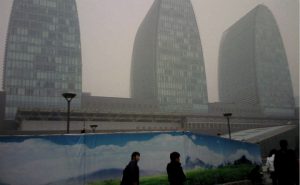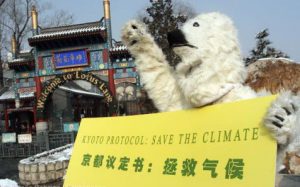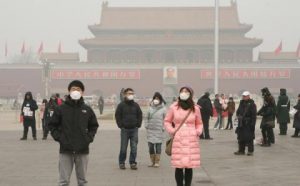Jiang Kejun is a fellow at the Energy Research Institute at the National Development and Reform Commission (NDRC)
chinadialogue (CD): At the same time that China’s representatives are at COP19, Chinese cities are still enveloped in smog. How is this affecting China’s emissions reduction process?
Jiang Kejun (Jiang): Efforts to deal with smog have been a huge spur to China’s emissions policy. It’s already clear that the heavily-polluted areas of China can have no illusions about increasing coal use – it must be cut. In the short term the target is smog and air pollution, but in the longer term emissions cuts will drive the economy.
Local officials don’t know what to do – in the past they based their careers on creating industrial zones to attract companies and investors to increase local GDP. Now they need to find some other ways of performing. Many local governments are looking to carbon and environmental targets to prove themselves. The State Council has also decided to use areas where there can be quality of life improvements – education, healthcare, transportation and environmental protection – to drive investment and the economy. If you give those local officials a way out, they’ll grab it.
CD: An NDRC source has said that the feasibility of a carbon emissions cap for the 13th Five Year Plan is being examined. Is that one of the policy improvements brought about by the worsening smog?
Jiang: We’re currently researching targets for the 13th FYP. China’s domestic policies are moving quickly, which means we can be more radical in international talks. The air pollution plan was much more progressive than I’d expected. Initially we looked at a total energy consumption cap, but nobody believed China would do it. But now it looks like Chinese policy could bring the [carbon consumption] cap forward again, and then the targets of the 13th FYP could all come forward.
CD: That would mean that after making changes to the cap targets in both the 11th and 12th FYP, the 13th FYP may see bigger changes to emission policy?
Jiang: In the 11th FYP China implemented energy intensity targets, and in the 12th FYP total energy consumption targets and energy intensity targets were both used. Over that decade the energy intensity targets didn’t do much to promote emissions reduction – these are based on GDP and as such are indeterminate and rely on accuracy of statistics. The 13th FYP should ideally shift to energy and CO2 caps – the energy cap as a main target, and the CO2 cap supporting.
Currently smog is driving policy changes. A carbon emissions cap may be included in the 13th FYP, and that would provide new guidance for emissions reduction policy.
CD: Are changes needed to China’s climate policy mechanisms and institutions?
Jiang: Strong climate policy signals need to be sent if more forceful carbon cuts are to be made. Both President Xi Jinping and Premier Li Keqiang have made their determination clear, and government departments are working faster.
The National Energy Administration is quite practical – it focuses on actual operations, and pays no attention to the negotiations. The Ministry of Industry and Information Technology has already set a carbon intensity target. Chinese industry accounts for 70% of the country’s energy consumption, and as the industrial regulator the MIIT is feeling that pressure and has been investigating what it can do.
When it comes to the institutions, the NDRC’s Department of Climate Change is mainly in charge of negotiations, but it should be in charge of, and able to strengthen, climate policy. If this policy remains conservative the national interest may be harmed. It can’t try to protect the old model of economic growth and wait for incidents of pollution or environmental disasters to bring about change.
According to our analysis, China’s CO2 emissions from energy activities will peak around 2025, on the assumption that by 2020 the developed nations have cut emissions by 30% on 1990 levels, and other developing nations take strong action to cut emissions.
CD: Overall, what are the prospects for emissions cuts in China?
China’s economic structure will change hugely in the run-up to 2020, with the output of the vast majority of energy-hungry industries having peaked and started to fall, removing the drivers of increased energy consumption. Also, China already has the policy and social environment for developing a low-carbon economy. By 2013 the costs of wind and photovoltaic (PV) solar installations had dropped significantly and in some coastal areas wind power generation is competitive with coal-fired power. At the consumer end, PV solar is becoming competitive. China’s near-term and 2020 renewable energy targets have repeatedly been raised. Also, China’s rapidly-growing economy allows for sustained low-carbon investment. Strong climate policy will promote China’s global technological leadership and economic growth.
That prediction could translate into a negotiation advantage for China – along with other leaders on climate change, China can push for global emission cuts and create a new international position for itself.
On current performance China’s GDP will pass that of the US in 2018, and by 2030 will be equal to the total GDP of the US, the EU and Japan. By that point China will be able to fund international emissions reductions. All of today’s policy design should be preparing for that point.
At the same time, China’s emissions will soon account for one-third of the global total. The national interest requires China to reposition itself and take its changing role seriously. Nothing should stand in the way of emissions cuts, of economic restructuring and new policies – the future direction is clear.
Of course, good policy design and investment are preconditions. I’m very confident about this. The signs are all clear: the coal-based high-emissions path we have taken is at an end.





